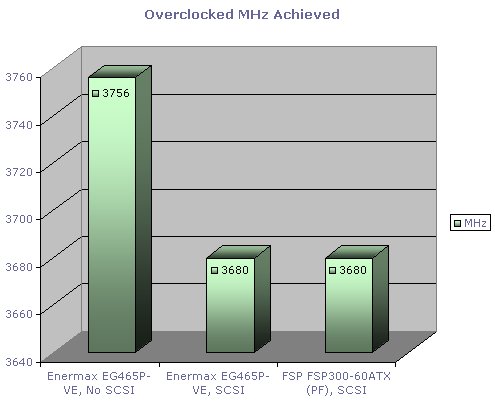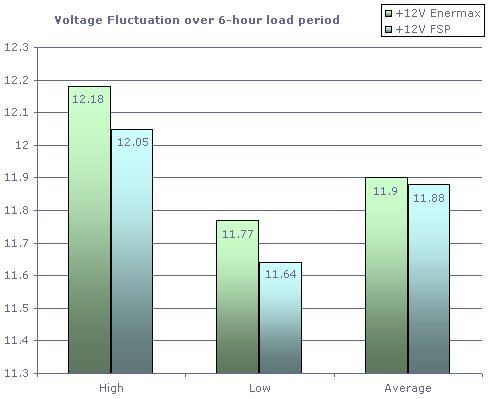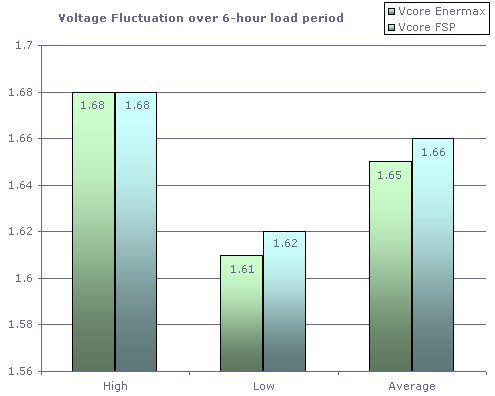|
The air cooling result from the 3.06GHz review was a heady 3.76GHz (which used my usual Enermax supply) so it'll be interesting to see the overclocking ceiling with the extra SCSI hardware load.
 Drop in overclock due to high CPU speed and extra device load
Drop in overclock due to high CPU speed and extra device load
An interesting graph that shows us a couple of things. Firstly, device load on your power supply will affect its performance. As the PSU is made to do more work, it can't maintain the current loads and voltage levels needed to keep the system stable compared to a situation where there is less device load.
What it also shows us is that the FSP PSU delivers on its promise of a high quality supply to your devices and motherboard by keeping up exactly with the higher specified Enermax. Impressive clock speeds for a 300W supply and for me at least, puts a lid on the "bigger output is better" mantra people seem to follow when purchasing a PSU. So while high output can be desirable, it's not the decisive factor all the time.
We'll take a look at how the supply does compared to the Enermax, both with the SCSI device load, on a couple of voltage rails as monitored by Motherboard Monitor 5.1.9.1. CPU speed for these tests was approximately 3.52GHz (153MHz front side bus).
First up, the +12V rail, one that takes a hammering at high front side bus frequencies on overclocked Pentium 4 systems.
 Enermax outperforms the FSP in peak situations, but it's very even over 6 hours
Enermax outperforms the FSP in peak situations, but it's very even over 6 hours
While the peak and low voltages of the Enermax are slightly better than the FSP, the average voltage level on the FSP over 6 hours of load is more than a match for it's higher specced opponent.
The low value of 11.64V happened about 20s after booting and seems to coincide with the DVD drive being accessed and the contents of the disk read. The corresponding low value on the Enermax happens at the same point.
At such a high CPU speed and decent PSU load with plenty of devices to run, both PSU's do things especially well.
The CPU core voltage is the other line you like to keep an eye on when you are overclocking a system. Running the CPU out of specification almost always requires increasing the core coltage of the processor so maintaining a stable core voltage line is needed to let you run your CPU out of spec. Dropping too low will almost always generate an error or crash your system and too much Vcore can cause heat related issues, so a stable Vcore is essential when pushing your system.
 FSP turns the tables with better Vcore results
FSP turns the tables with better Vcore results
While there's not much in it, 6 hours of load is guaranteed to smooth out the peaks and dips unless your PSU is wildly erratic and in this case, even at 3.5GHz and constant CPU load, both PSU's do very well with the FSP actually holding a closer average value to the chosen Vcore voltage of 1.68V than the Enermax.
There's a similar story across the board with the other voltage lines measured by Motherboard Monitor with the Enermax and FSP trading blows with regards to average voltage being close to expected voltage over the 6 hour load period.
So we know we have a decent performing supply in the FSP, at least on a par with the Enermax EG465P-VE I've had as my long term test PSU for well over a year now. While I can't comment on the rest of FSP's range just from testing a single unit, I wouldn't pass them by if I saw them in a PSU line up now.
On last thing to comment on before we wrap things up!
|